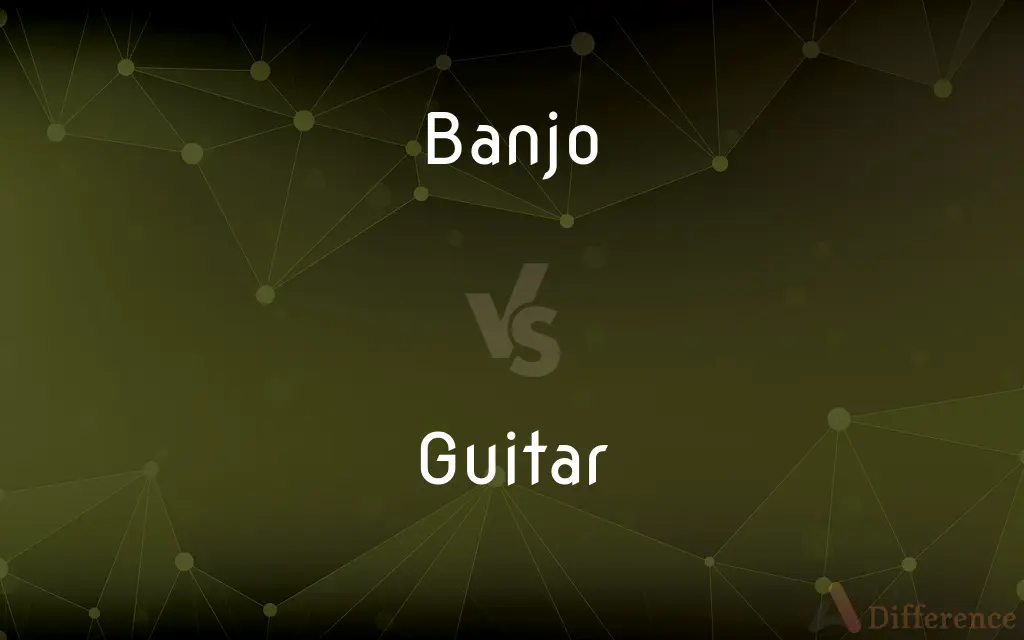Banjo vs. Guitar — What's the Difference?
By Maham Liaqat & Urooj Arif — Updated on April 17, 2024
A banjo typically has a circular drum-like body and a distinctive twangy sound, ideal for folk and bluegrass music; guitars have a flat, resonant body and are versatile across many musical genres.

Difference Between Banjo and Guitar
Table of Contents
ADVERTISEMENT
Key Differences
A banjo often features a circular body with a drum-like membrane that produces a bright, sharp, and twangy sound. On the other hand, guitars have a flat wooden body that resonates to produce a richer, more versatile tonal range.
Banjos typically have four or five strings and are associated with specific playing styles like clawhammer and bluegrass rolls. In contrast, guitars usually have six strings, though variations with twelve strings or more exist, allowing for a wide range of playing techniques including strumming, picking, and fingerstyle.
The banjo’s design includes a short neck and a high-tension bridge to maintain the distinctive sound, while guitars have a longer neck and a lower tension bridge, which supports diverse musical expression and is easier on the fingers.
Banjos are predominantly used in specific music genres such as folk, country, and bluegrass due to their unique sound. Whereas, guitars are incredibly versatile and used in virtually every music genre, from classical and jazz to rock and pop.
While learning to play the banjo might be simpler due to fewer strings and specific playing techniques, mastering it requires dedication to its unique style. Conversely, the guitar’s learning curve might be steeper, but it offers broader musical opportunities and is generally more popular globally.
ADVERTISEMENT
Comparison Chart
Body Shape
Circular drum-like
Flat, varied shapes (e.g., classical, dreadnought)
Sound
Bright, twangy
Rich, versatile
Typical String Count
4 or 5
6 (commonly), but varies up to 12 or more
Associated Genres
Folk, country, bluegrass
Rock, jazz, classical, blues, pop, and more
Playing Techniques
Clawhammer, rolls
Strumming, fingerstyle, picking
Compare with Definitions
Banjo
Typically has a short, fretted neck.
The intricate inlays along the banjo's neck caught everyone's eye.
Guitar
Versatile across many musical styles and genres.
The guitarist switched effortlessly between jazz and rock during the concert.
Banjo
Commonly used in folk and bluegrass music.
The band's banjo player set the pace for their bluegrass performance.
Guitar
A musical instrument with six strings stretched over a fretted neck.
He strummed his guitar softly by the campfire.
Banjo
A stringed instrument with a circular membrane stretched over a frame.
He played an upbeat tune on his five-string banjo.
Guitar
Used globally and integral to many cultural music traditions.
The flamenco guitarist captivated the audience with rapid finger movements.
Banjo
Known for its sharp, twangy sound.
The banjo's twangy notes echoed through the hall.
Guitar
Produces sound through vibrations from strings amplified by a wooden body.
Her guitar's rich tones filled the cozy cafe.
Banjo
Often played with specific finger-picking techniques.
She mastered the clawhammer technique on her banjo.
Guitar
Can be acoustic or electric.
He plugged his electric guitar into the amplifier, ready to rock.
Banjo
The banjo is a stringed instrument with a thin membrane stretched over a frame or cavity to form a resonator. The membrane is typically circular, and usually made of plastic, or occasionally animal skin.
Guitar
The guitar is a fretted musical instrument that typically has six strings. It is held flat against the player's body and played by strumming or plucking the strings with the dominant hand, while simultaneously pressing selected strings against frets with the fingers of the opposite hand.
Banjo
A usually fretted stringed instrument having a narrow neck and a hollow circular body with a covering of plastic or stretched skin on which the bridge rests. The modern American banjo typically has four strings and often a short fifth string plucked with the thumb.
Guitar
A stringed musical instrument, with a fretted fingerboard, typically incurved sides, and six or twelve strings, played by plucking or strumming with the fingers or a plectrum.
Banjo
A stringed musical instrument (chordophone), usually with a round body, a membrane-like soundboard and a fretted neck, played by plucking or strumming the strings.
I come from Alabama with my banjo on my knee...
Guitar
A musical instrument having a flat-backed rounded body that narrows in the middle, a long fretted neck, and usually six strings, played by strumming or plucking.
Banjo
Any of various similar musical instruments, such as the Tuvan doshpuluur, with a membrane-like soundboard.
Guitar
(musical instrument) A stringed musical instrument, of European origin, usually with a fretted fingerboard and six strings, played with the fingers or a plectrum (guitar pick).
Learning to strum the guitar rhythmically is essential.
She was carrying her guitar in a fancily-decorated case.
The band is looking for a new guitar player.
Banjo
(slang) An object shaped like a banjo, especially a frying pan or a shovel.
Guitar
(musical instrument) Any type of musical instrument of the lute family, characterized by a flat back, along with a neck whose upper surface is in the same plane as the soundboard, with strings along the neck and parallel to the soundboard.
Banjo
A cul-de-sac with a round end.
Guitar
(rare) To play the guitar.
Banjo
(mining) A miner's round-nosed shovel.
Guitar
A stringed instrument of music resembling the lute or the violin, but larger, and having six strings, three of silk covered with silver wire, and three of catgut, - played upon with the fingers.
Banjo
To play a banjo.
Guitar
A stringed instrument usually having six strings; played by strumming or plucking
Banjo
To beat, to knock down.
Banjo
To shell or attack (a target).
Banjo
A stringed musical instrument having a head and neck like the guitar, and a circular body like a tambourine. It has five strings, and is played with the fingers and hands.
Banjo
A stringed instrument of the guitar family that has long neck and circular body
Common Curiosities
Are there different materials used in banjo and guitar construction?
Yes, banjos typically use a combination of wood and a synthetic or animal skin head, while guitars are primarily made of various woods, and electric guitars may incorporate metals and plastics.
What role do banjos and guitars play in a band setting?
In a band, a banjo often provides a rhythmic and melodic drive with its crisp sound, especially in country and folk settings, while guitars can serve as rhythm or lead instruments across a wide range of genres.
What are the educational resources like for learning banjo versus guitar?
There are extensive resources for learning both instruments, but the guitar has more widespread instructional materials and online tutorials due to its popularity.
What is the historical origin of the banjo?
The banjo originated in Africa and was brought to America by enslaved Africans. It evolved from African stringed instruments and became popular in American folk and bluegrass music.
How does the playing technique differ between banjo and guitar?
Banjo playing often involves rolling finger-picking patterns, while guitar playing can range from simple strumming to complex fingerstyle techniques and fast picking.
What famous musicians are known for playing the banjo?
Famous banjo players include Earl Scruggs, known for pioneering modern bluegrass banjo techniques, and Béla Fleck, who has expanded the instrument's use into jazz and fusion.
How do the physical dimensions of banjos and guitars compare?
Banjos are generally smaller and lighter than most guitars, with a narrower neck, which can make them easier to hold for some players.
How do the costs of banjos and guitars compare?
The cost can vary widely depending on the quality and brand, but entry-level guitars are generally more available and affordable compared to entry-level banjos.
Can you convert a guitar to sound like a banjo?
While a guitar cannot be converted to a true banjo, a "banjitar" or six-string banjo tuned like a guitar is available for guitarists wanting a banjo sound without learning a new instrument.
What are the main types of banjos?
The main types of banjos include the 5-string banjo, used primarily in bluegrass music, and the 4-string tenor banjo, popular in Celtic music.
What makes the banjo suitable for bluegrass music?
The banjo's bright, percussive sound complements the rapid, syncopated rhythms typical of bluegrass music.
Can guitars have more than six strings?
Yes, guitars can have more than six strings, such as the twelve-string guitar or extended-range guitars like the seven or eight-string guitar, which add lower-pitched strings.
How does the sound of a banjo differ from a guitar?
The banjo has a sharper, more metallic sound due to its drum-like body, whereas the guitar has a deeper, more resonant sound thanks to its larger wooden body.
What famous musicians are known for their guitar playing?
Iconic guitarists include Jimi Hendrix, Eric Clapton, and B.B. King, who have been influential in the development and popularization of various guitar styles and techniques.
Why is the guitar considered more versatile than the banjo?
The guitar's ability to produce a wide range of tones and its adaptability to various playing styles make it suitable for a broad spectrum of musical genres.
Share Your Discovery

Previous Comparison
Unannotated vs. Annotated
Next Comparison
Warlock vs. ShamanAuthor Spotlight
Written by
Maham LiaqatCo-written by
Urooj ArifUrooj is a skilled content writer at Ask Difference, known for her exceptional ability to simplify complex topics into engaging and informative content. With a passion for research and a flair for clear, concise writing, she consistently delivers articles that resonate with our diverse audience.















































